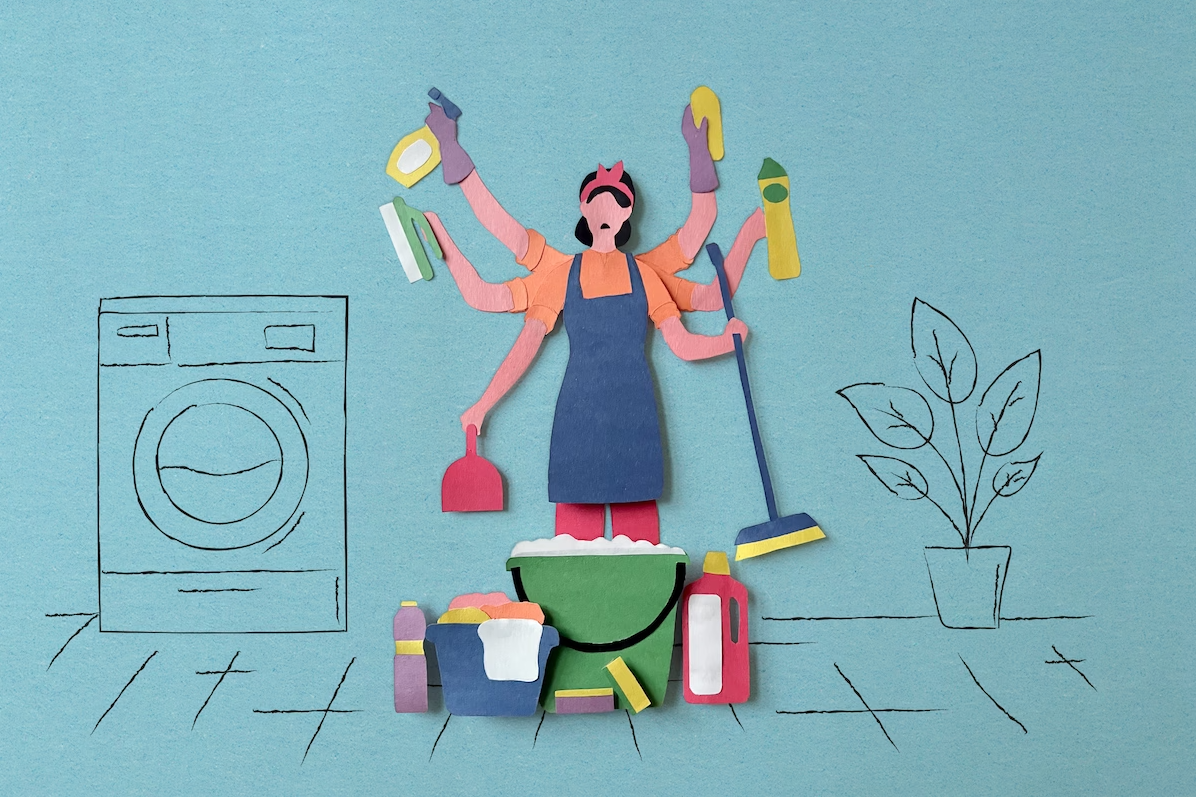
This article is more than
1 year old
There is no shortage of guides explaining the proper way to do chores and how frequently we should be doing them. While the advice is often helpful, it is, to an extent, subjective. Some household tasks are strictly necessary — and some are a matter of personal preference or cultural norms. Identifying which ones are which can help you prioritize what’s important and be more forgiving of yourself.
And thinking more “big picture” about the root of your challenges — for example, an unfair distribution of labor, or having products that require heavy maintenance — can perhaps illuminate solutions. While there are certainly practical ways to reduce the burden of housework, the answer may include making peace with imperfection and knowing yourself.
Here are a few suggestions, practical and emotional, for making housework less overwhelming.
Ask yourself: What’s the worst that could happen?
We clean our homes for a number of reasons, including to protect against negative health effects — reducing the spread of germs and pathogens, preventing mold. But the list of chores that pose a serious health risk if done poorly is fairly short.
Any surface or item used to prepare, eat or clean food, such as sponges, countertops, sinks and cutting boards, should be thoroughly cleaned after each use, says Elaine Larson, professor of epidemiology emerita at Columbia University. And of course, toilets and bathroom sinks need frequent cleaning as well. But many other tasks often thought of as weekly or even daily chores, such as vacuuming and dusting, are “really for aesthetics,” Larson says. “You’re not going to get much in the way of infections from that kind of thing.”
Compromised immune systems or dust or mold allergies might require more diligence. But for the most part, nothing bad will happen if a couple of dust bunnies gather in the corner. Eliminating all bacteria at home is not realistic or necessary. There is even evidence that overly sterile environments don’t allow the immune system to develop.
“There are both good and bad bacteria,” says Rebecca Yee, assistant professor of pathology at George Washington University. “The good bacteria are what we call commensals and commensal organisms have a protective role. Without the good bacteria in the gut, an individual may not be able to tolerate common allergens.”
Some of the things we can do to minimize health risks don’t require any labor, such as airing out rooms and investing in air purifiers with HEPA filters. In areas with high humidity, a dehumidifier can help prevent mold build up or attraction of dust mites, Yee says.
Put cleaning standards in perspective
Laura Vanderkam, author of “168 Hours: You Have More Time Than You Think,” has interviewed hundreds of people about how they spend their time. She has also found that expectations around cleaning used to be even higher. Poring through old women’s magazines, she saw articles on niche topics including the exact way to put floor wax on a brush when waxing the floors. “That is a tip that I cannot really use in my life,” she says. “But that was the subject of an article in the 1960s.”
As more women entered the paid workforce, some standards relaxed, and the result was not catastrophic. “What people felt was worth doing declined over the decades,” she says. “But I don't think, for a normal person, that crossed the line of health and sanitation, which suggests that a lot of what was being done was not strictly necessary.”
In my household, we’ve gone weeks without deep cleaning the fridge, for instance, and life went on as normal. That doesn’t mean I wouldn’t have been embarrassed if someone else looked inside it, which speaks to another reason we clean. Research suggests that women are judged more harshly for messiness, so it’s understandable that they may feel especially pressured to keep up appearances. But that finding also suggests that for cleaning standards to become more realistic and forgiving, we need to collectively loosen up a bit. Perhaps relieving pressure on others begins with being kinder to ourselves.
Share the burden
Women, on average, spend more time on housework than men. A 2023 report by the Pew Research Center found that in heterosexual marriages where both parties earn about the same amount or the wife earns more, women spend about 2.5 hours more each week on housework. Making housework less overwhelming begins with distributing labor fairly. That could also include calling on kids — especially teenagers — to share more of the load.
If you live with others and share household labor, Vanderkam suggests coming up with minimum standards together. For example, if a couple splits cooking, they might agree that it’s not acceptable for one person to always order pizza on their nights, but once per week is okay, or that every meal should include at least one vegetable.
Spend less time caring for clothes
Vanderkam, a mother of five, sees many of her fellow parents lamenting tasks they could choose not to do. Folding a toddler’s clothes, for instance, strikes her as particularly unnecessary.
“Does it have to be folded into a neat, creased pile, or could you just loosely toss T-shirts in a drawer and pull them out as you need?” she asks. “One takes a lot more time.”
By the same token, she suggests buying clothes that don’t require intense care. She favors Betabrand “dress pant yoga pants,” which resemble traditional slacks but can be machine washed. If you hang up clothes as soon as they’re dry, or wear clothes that don’t wrinkle easily, you can forgo ironing and folding.
Also keep in mind that many items do not need to be laundered after every use. Towels can handle a few uses if they’re hung up to dry. Jeans, as the CEO of Levi’s famously declared, hold up better if rarely washed. Some fashion industry experts also say that most people over-wash knitwear, which only needs to be cleaned once per year.
To avoid sorting laundry, Halton washes only one person’s clothing at a time. She also suggests buying all the same type and color of socks. I’ve also found that having storage cubes on both sides of the bed provides a holding place for sweatshirts and other frequently worn items between washes.
Clean the floor less often
Removing shoes upon entering the home, which is customary in many parts of the world, minimizes how much dirt and debris is tracked inside. “We have always been a ‘no shoes household,’ as it saves so much time on cleaning the floors,” says Chrissy Halton, a British content creator and former professional organizer. For those who still want supportive footwear, consider having designated “inside shoes.” (Mine are Crocs, to my husband’s chagrin.)
Beyond that, spot-cleaning stains, such as a splash of coffee, could take less time than a full mopping session. You can also try a robotic vacuum, which comes with pros and cons but can keep everyday dirt and pet hair at bay.
Sticking to a few easy meals on a rotation simplifies meal planning and shopping. “Like, every Monday is pasta,” says Vanderkam. “Every Tuesday is breakfast for dinner. Every Thursday is make your own pizza. Then nobody has to think about what’s for dinner on those nights, and you always get those groceries.”
Prioritizing meals that use minimal pans — such as a large pot of soup or sheet-pan suppers — results in less cleanup. Experts say dishes do not need to be pre-rinsed before going in the dishwasher. And if you hate drying dishes by hand? Good news: Letting them air dry is more sanitary anyway, says Erica Wides, the chef behind popular Instagram account thechefsmartypants. As for lunch prep, Vanderkam says once her kids are 8 years old, they’re expected to either make their own lunch or buy it at school.
Keep children’s things at bay
The nightly slog of picking up kids’ things is a chore many parents know all too well, but it’s not necessarily worth it. “I can promise you that those toys are just going to come out again the next morning, and you are not going to get that time back,” says Vanderkam. “It would be better to just acknowledge that and maybe use that time for leisure or going to bed a little bit earlier, so you can fight the good fight again the next day.”
She suggests finding one area to keep as a tidy sanctuary for yourself, rather than trying to tackle every room every day. If you can toss clutter in large bins so they’re out of sight, or focus on clearing horizontal surfaces like tabletops, that will make a space feel cleaner even if much is left undone.
Simply having fewer toys and games is another way to cut back on mess, and may have other benefits. A 2018 study from the University of Toledo in Ohio found that when toddlers have fewer toys in their environment, it encourages them to focus more and play more creatively.
Do your own experiments
For areas that aren’t hotspots for health risks, consider waiting a little longer to do a certain task and see if you can tell the difference. Halton says she thinks in terms of how often an area or item is used. She’s the only one who uses her en suite shower, for instance, so she doesn’t believe it warrants a deep clean every week. “You can’t ever say one cleaning schedule will work for everyone because it totally depends on that ‘cost per use’ idea,” she says.
She’s also gone down to polishing the furniture every two weeks, rather than weekly, and hasn’t noticed a difference. Halton says it’s liberating to be more in control about what needs to be done. “The perfectionist inside me is less fraught as well, as I don’t try and chase an ideal that’s impossible.”